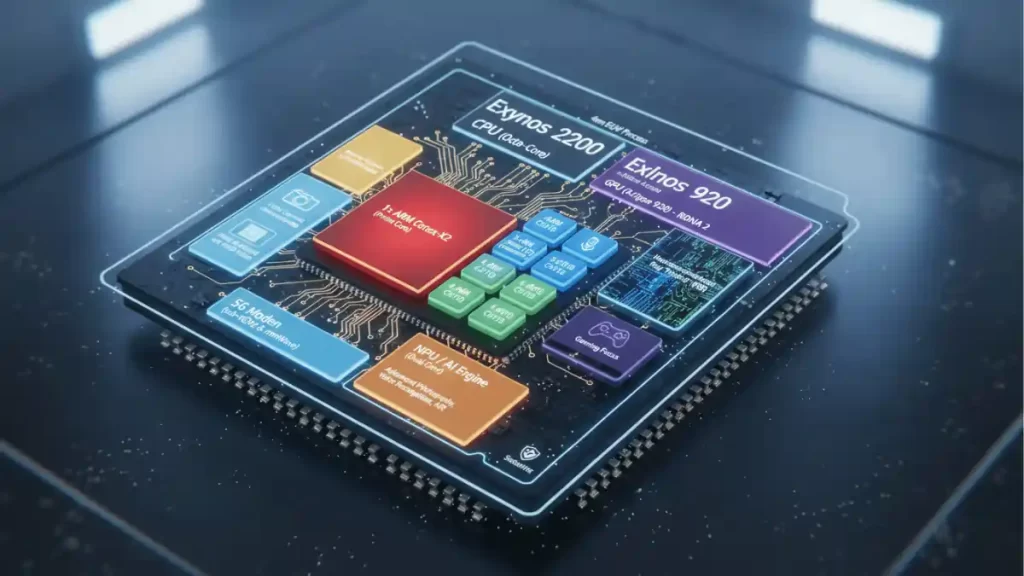
Definition: Samsung’s 4 nm system-on-chip with an ARM CPU cluster and an AMD-based Xclipse GPU. It supports 5G, hardware video encode/decode, and features like high-resolution cameras and 120 Hz displays. Real-world performance and heat depend on tuning, storage speed, and software.
The Samsung Exynos 2200 is a high-end system-on-a-chip (SoC) designed by Samsung Electronics, primarily for its flagship Galaxy smartphones. It was officially unveiled in January 2022.
Here’s a breakdown of its key design aspects and what makes it noteworthy:
1. CPU (Central Processing Unit)
The Exynos 2200 features an octa-core CPU configuration using ARM’s v9 architecture in a tri-cluster setup:
- 1 x ARM Cortex-X2 (Prime Core): This is the most powerful core, clocked at a high frequency, designed for peak performance in demanding tasks like gaming or heavy application usage.
- 3 x ARM Cortex-A710 (Performance Cores): These cores balance performance and efficiency, handling most everyday tasks and sustained workloads.
- 4 x ARM Cortex-A510 (Efficiency Cores): These are the most power-efficient cores, used for background tasks, light browsing, and to conserve battery life.
This heterogeneous computing approach allows the chip to dynamically allocate tasks to the most appropriate cores, optimizing for both performance and power efficiency.
2. GPU (Graphics Processing Unit) – Xclipse 920
This is arguably the most significant design aspect of the Exynos 2200. Samsung collaborated with AMD to integrate an Xclipse graphics processing unit, which is based on AMD’s RDNA 2 architecture. This collaboration brought several firsts to mobile SoCs:
- Hardware-accelerated Ray Tracing (RT): Ray tracing is an advanced rendering technique that simulates the physical behavior of light, resulting in much more realistic lighting, reflections, and shadows in games and graphics. The Exynos 2200 was one of the first mobile chips to support this at a hardware level.
- Variable Rate Shading (VRS): VRS allows developers to selectively reduce the shading rate in parts of an image where detail is less critical (e.g., distant objects or areas blurred by motion), improving performance without a significant perceived loss in visual quality.
- Gaming Focus: The RDNA 2 architecture is the same one used in current-generation gaming consoles (like PS5 and Xbox Series X) and PC graphics cards, suggesting a strong focus on enhancing mobile gaming experiences.
3. NPU (Neural Processing Unit) / AI Engine
The Exynos 2200 includes a dual-core NPU designed for artificial intelligence and machine learning tasks. This unit accelerates on-device AI operations, such as:
- Advanced photography features: Enhancing images, scene recognition, and computational photography.
- Voice recognition and natural language processing.
- Augmented reality (AR) applications.
- Overall system optimization based on user patterns.
4. Modem
It integrates a 5G modem that supports both sub-6GHz and mmWave frequencies, ensuring fast and reliable connectivity. It also supports older network standards.
5. ISP (Image Signal Processor)
The ISP is crucial for camera performance. The Exynos 2200’s ISP is designed to handle high-resolution camera sensors, support multiple cameras simultaneously, and perform advanced image processing to deliver high-quality photos and videos. It can support resolutions up to 200 MP and 4K HDR video recording.
6. Manufacturing Process
The Exynos 2200 is fabricated using Samsung Foundry’s 4-nanometer (4nm) EUV (Extreme Ultraviolet Lithography) process. A smaller process node generally means:
- More transistors in a smaller area: Leading to increased performance.
- Improved power efficiency: Less power consumption for the same amount of work.
- Reduced heat generation.
7. Memory Support
It supports LPDDR5 RAM, offering high bandwidth and low latency for fast data access, which is essential for demanding applications and multitasking.
8. Security
Like other modern SoCs, it incorporates a secure element and various security features to protect user data and ensure the integrity of the device.
Overall Design Philosophy:
The Exynos 2200 represents Samsung’s ambition to create a highly competitive flagship SoC, particularly by leveraging AMD’s GPU technology to push the boundaries of mobile graphics. It aims for a balance of raw CPU performance, cutting-edge graphics capabilities, advanced AI processing, and efficient power management, all manufactured on a leading-edge process node.
Example: Editing a short 4K clip uses the Exynos 2200’s media engines.
Also called: S5E9925
Related: SoC, Xclipse GPU, UFS 3.1 storage, LPDDR5 RAM
